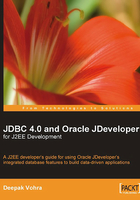
Chapter 1. JDBC 4.0
The Java Database Connectivity API is used to access a SQL database from a Java application. JDBC also supports tabular data sources, such as a spreadsheet. We will constrain our discussion to SQL relational databases. Using JDBC API, SQL statements can be run in a database. JDBC started as JDBC 1.0 API; JDBC 1.0 covered the basics of establishing a connection with a database, running SQL statements, retrieving values from result sets, and using transactions. JDBC 2.0 introduced scrollable result sets, JDBC methods to update a result set or a database table, batch updates, and SQL3 data types such as, BLOB, CLOB, Array, Ref, and Struct. JDBC 3.0 introduced savepoints, connection pooling of prepared statements, multiple open ResultSet objects, BOOLEAN data type, and an interface for parameter metadata and for retrieving database metadata. JDBC 4.0 specifications added some new features, which we will discuss in this chapter.
The JDBC API provides various interfaces and classes for accessing a database; creating tables in the database; and adding, updating, deleting data, in the database tables. In the following sections, we will discuss some of the JDBC classes and interfaces. We will also discuss the new methods added to these classes or interfaces, in JDBC 4.0 specifications. To run a JDBC 4.0 application, install a RDBMS database such as the open-source MySQL database or the commercial Oracle database. A JDBC driver class is required to establish a connection with the database. JDBC drivers are vendor-specific. A JDBC driver class implements the java.sql.Driver interface.